Miles Olusina writes a detailed tactical analysis about the Bundesliga match that ended Gladbach 0-1 Bayern.
Week 25 of the 2016-17 Bundesliga season saw league leaders Bayern Munich up against Borussia Monchengladbach at the Gladbach Stadium. With their nearest rivals RB Leipzig being hammered 3-0 by Werder Bremen the day before, Bayern were keen to come away with the victory in this game to extend their lead at the top of the table to 13 points. Their opponents had very little to play for, having been lingering in mid-table for much of the season and came into this fixture in 10th place, a far cry from their 4th place finish in the previous campaign.
Bayern selected a typically strong line-up, continuing with their hybrid 4-4-2/4-3-3 formation with Muller functioning as a second striker. This game proved more difficult than most as Bayern struggled to break down Gladbach’s stubborn and compact block, partly due to superb organization and spacing between the lines and Bayern’s inability to create effective positional structures for much of the first half. An improvement in this aspect as the game went on was influential in Bayern snatching the win with a Thomas Muller goal coming from a Thiago Alcantara assist in the 62nd minute.
GLADBACH 0-1 BAYERN
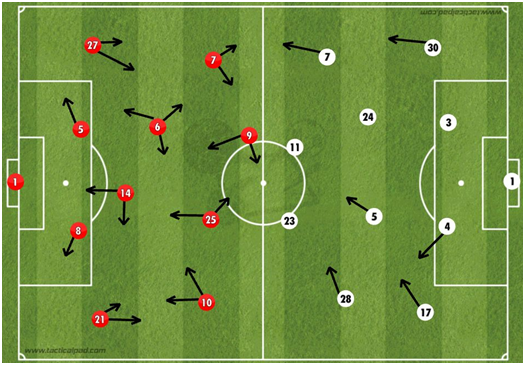
Made using TacticalPad
Gladbach (4-4-2): 1. Sommer // 30. Elvedi, 3. Christensen, 4. Vestergaard, 17. Wendt // 7. Herrmann, 24. Jantschke, 5. Strobl, 28. Hahn // 11. Raffael, 23. Hoffmann
Bayern (4-3-3/4-4-2): 1. Neuer // 21. Lahm, 8. Martinez, 5. Hummels, 27. Alaba // 14. Alonso, 6. Thiago, 10. Robben, 7. Ribery // 25. Muller, 9. Lewandowski
Substitutes: 63’ Hazard (Herrmann), 72’ Drmic (Jantschke), 80’ Benes (Hahn) // 72’ Coman (Ribery), 76’ Kimmich (Alonso), 84’ Sanches (Robben)
Goal(s): 62’ Muller
Gladbach’s 4-2-2-2 shape and co-ordinated pressure
From the outset, it was apparent that the home side set out to frustrate the league leaders; knowing full well that Bayern were likely to dominate the ball. Their best chance of grabbing a victory was by remaining organized and hoping to exploit any open spaces in attacking transitions. They were very difficult to break down especially during the early stages of the game as a result of their excellent spatial control and vertical compactness.
They refrained from pressing with much intensity as a unit for most of the game as they knew Bayern were more than capable of finding free men behind their waves of pressure. Instead they sought to condense the space between each of the lines as much as possible, only allowing space when they looked to press in midfield; however that was only when there was access.

Gladbach are set up here in their 4-4-2 shape with a passive front 2 in the 6 space, giving an inordinate amount of time on the ball to the Bayern centre backs. This decision may seem puzzling to most considering the ball playing proficiency of the Bayern centre backs, however it makes sense as from the image we can see that they lack any viable vertical options.
This is due to the spatial occupation of Gladbach as I alluded to earlier; with the key spaces on the field being overloaded by the compact Gladbach block, none of the more advanced Bayern players can receive the ball in any real amount of space and are therefore rendered ineffective. The wide men of Gladbach have accounted for the indenting Bayern wingers and come inside also, occupying the half-space and cover shadowing their opponents.
This compact shape could easily have been unraveled with intelligent movement from the Bayern forwards; however Gladbach boss Dieter Hecking was sure to instruct his players not to make the Bayern players and their movement the primary defensive reference point. Had they done so it would have been all too easy for the Bayern midfielders and forwards to drag individual Gladbach players out of their position by rotational movements and roaming from their base positions, therefore severely compromising the compactness of their defensive block.
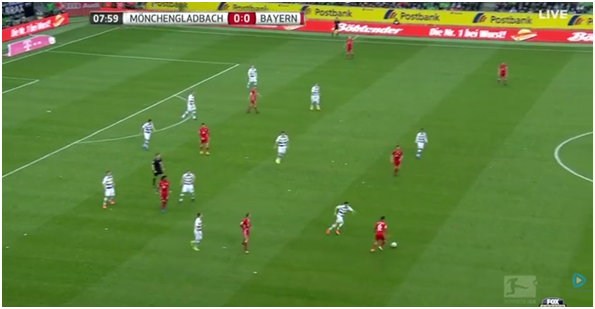
Thiago is in possession here but again is unable to combine with his Bayern teammates who are suffering from poor connections as a result of Gladbach’s shape and defensive orientation. Their primary focus tended to be their position within the block with greatly enhanced their organization. When Bayern were in possession and there was access, the nearest player would press while the surrounding players would cover shadow the nearest passing options as we can see with Thiago in possession here.
Bayern struggle to gain central presence, switch focus to wings
With space in the centre hard to come by, Ancelotti opted for a different approach for his Bayern side, choosing to exploit the space vacated out wide by the opposition. They became heavily reliant on combinations between the full back and wingers with one occupying the wing while the other moved into the half space that would be left open by the Gladbach wide man moving out of position to apply pressure. This caused a threat on occasion, disorganizing the Gladbach shape from time to time.
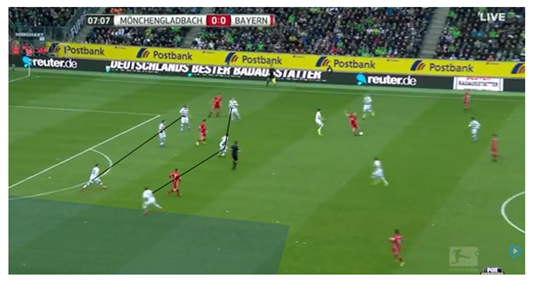
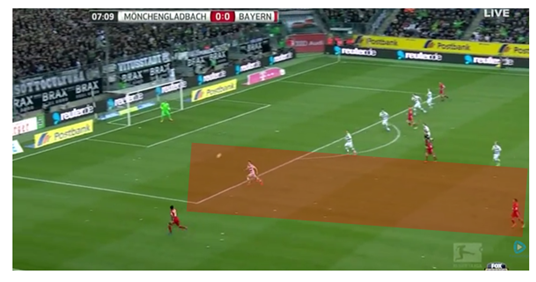
The scenario above is when they often found the most success when exploiting the wing space vacated by the Gladbach block. Ancelotti intelligently advised his side to overload one side of the field before switching the ball to the free man on the underloaded side of the field. Robben is in possession and is preparing to switch the ball through the now free half-space. The rest of his supporting players have all moved within close proximity of him before the switch to force the Gladbach block to shift as they do not want to risk being overloaded on one side of the field. Lewandowski, Muller and even Ribery, who was initially out on the left wing has moved centrally to force a ball-oriented shift from the Gladbach defensive block.
The ball was then switched to Alaba which had detrimental effects on the opposition shape as they tried to re-adjust and shift to the other side. Alaba receives possession and as we can see the Gladbach defence is nowhere near as organized as it was previously due to the difficulty required when shifting from one side to another immediately after.
With the rest of the block still shifting as the ball reaches Alaba, he was a wealth of time and space on the ball to pick out Thiago who is now free in the half-space. He now has more than enough time and space to play a through pass to one of the forward players making a vertical run in behind the defence, which Gladbach appeared to be susceptible to throughout the game.
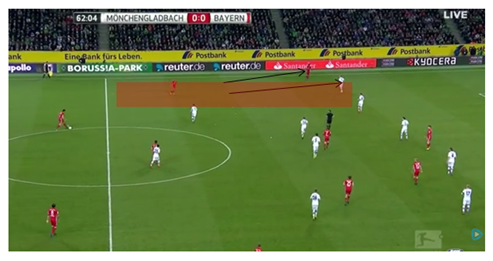
The movement of the full backs in the wide area, particularly David Alaba proved crucial throughout the game. With the opposition rarely engaging in man orientations, Alaba was often free to make third man runs into the final third untracked which often caused a danger and allowed him to play dangerous balls into the box.
It was in this image above, which led to the goal that his movement proved the most effective. Hummels is in possession here and lays the ball off to Thiago who is in an abundance of space. This is made possible by David Alaba who has occupied a very advanced position almost on the same line as Robert Lewandowski. In response to this, Patrick Herrmann, leaves his position in the right half-space to allow himself access to Alaba should he receive the ball.
The end result is a back 5 shape and a large amount of room for Thiago in the half-space who is able to make a run into the final third unchallenged with possession. He then finds Muller who slots past Yann Sommer to give Bayern the lead.
Bayern poor positional structure and spacing in 1st half
As mentioned previously, Bayern’s struggles in the 1st half were not only due to Gladbach’s excellent defending but from their own inability to form adequate structures to allow for connectivity and combination play. Too often they suffered from poor spacing between each player in the early stages of the game and looked quite disjointed at times. As a result, circulating possession became difficult as did final third combinations.
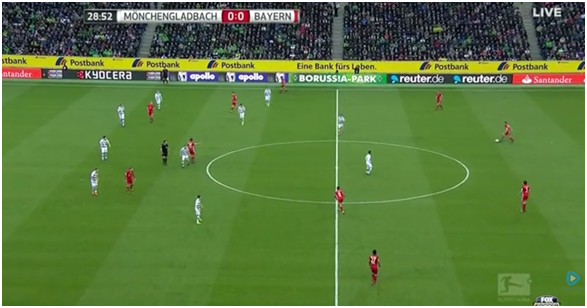
Bayern have possession here with Alonso and the problems with the shape of the team are quite apparent. He is looking to play the ball to the next line; however both of his most realistic passing options in Thiago and Muller are being cover shadowed by Gladbach midfielders. The height of the back line is problematic also in my opinion, as they could be much further up the pitch considering how deep the Gladbach forwards are positioned. A higher defensive line in this phase of play would have had serious benefits in that the side would be more compact vertically and better able to connect. Also it would invite the pressure from the Gladbach forwards, creating more space between the lines which Thiago could exploit with blind side positioning.
The effects would also be seen in their transition game as well, as with an already compact and organized shape they are better able to counter press and create overloads around the opposition ball carrier. Instead, they set up in this shape which did not allow them to play between the lines or penetrate the Gladbach block in any way. They were forced to play around the block in dreaded U-Shape, as described by former Bayern boss Pep Guardiola.
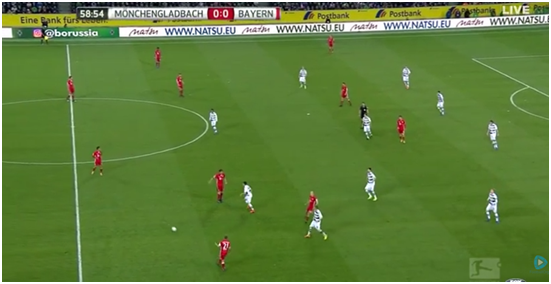
Bayern’s structure improved substantially in the second half, as we can see above with Lahm in possession. The key to this was the movement and positioning of the Bayern players in relation to the ball. In the first half, the movement was poor and did not facilitate the ability of the side to circulate the ball and play to the next line. Here we can see a much more compact Bayern team with the ball carrier having 2 or 3 viable passing options.
It is clear to see the effects of Pep Guardiola in the side, with their exhibition of Juego de Posición at near optimum level with no more than 2/3 players on the same vertical and horizontal lines and all the columns of the pitch being adequately occupied. The result is enhanced connectivity for the side as a whole and increased options for the Bayern man in possession.
Conclusion
Bayern will be very happy to have come away with a result in what was a very difficult game for the Bavarians. This all but seals a 5th consecutive league title for them as a 13 point lead with 9 games to go seems all but insurmountable by the chasing pack. The league leaders will likely shift their focus to the cup competitions, with the DFB Pokal semifinal against Dortmund and a Champions League tie with Real Madrid in the coming month.
Gladbach can feel proud of their performance despite not coming away with the result they would like. This was a promising performance in what has been a disappointing season from a team still clearly feeling the effects of losing their star man Granit Xhaka to Arsenal. As for the rest of the season, the best they can hope for is a push for a Europa League spot should they find some late season form.
Read all our other tactical analyses here
- Scout Report: Marcus Thuram | Gladbach’s attacking sensation - July 17, 2020
- Tactical Philosophy: Paulo Fonseca - May 28, 2020
- Maurizio Sarri at Chelsea: Tactical Approach & Key Players - September 5, 2018























































